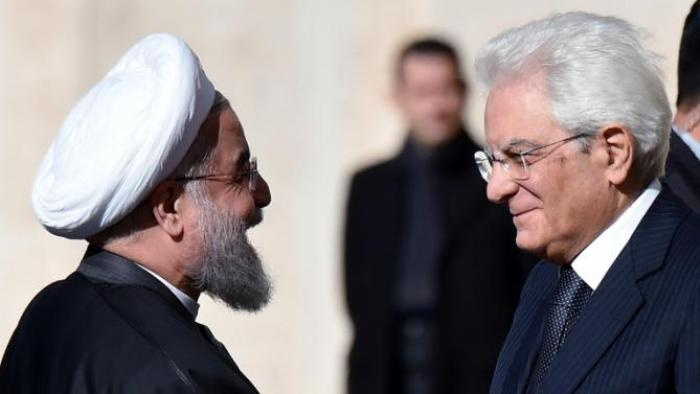Status and Statues

(Rouhani greeted by Italian President Sergio Mattarella. Source: AFP)
As Hassan Rouhani was on his historical European tour to Italy and France, his hardliner critics in Iran were busy nitpicking the details of his visit.
Rouhani’s press conference in Rome, where he expressed hope that the Guardian Council removes concerns about elections raised the anger of Raja News. The hardliner website unabashedly criticized the allegedly 'pro-West' Rouhani for “disclosure with his Western allies”, i.e. speaking of domestic issues in an international occasion.
“Attack on the Guardian Council … specially abroad and in presence of foreign correspondents whose mission is to spread false news against the Islamic Revolution … is not only wrong, but also an act that even the most amateur politicians would avoid” the website wrote in a piece on Wednesday.
Fault-finding took a cultural turn, however, when Hossein Dehbashi, director of Rouhani's 2013 presidential campaign advertisements who was later banished from the president's inner circle, found a symbolic significance in the venue of the joint presser of Hassan Rouhani and Italian PM Matteo Renzi.
“I am sure that a president as patriotic as Dr. Rouhani has become extremely upset afterwards, but didn’t his cultural and media advisors have the necessary literacy or vigilance to cast a moment of doubt over the exceptional choice of the Rome municipality’s Capitoline Museum for holding an official meeting between the heads of the two countries and signing a load of MoUs? And in the shadow of Marcus Aurelius Antoninus, … the man who crushed Iranians in the age of Parthians and the rule of the Arsacid dynasty?” Apparently, Dehbashi had seen this as an intentional move by the Italian side to humiliate Iranian guests through revival of historical confrontations between archenemies of the ancient world, the Romans and the Persians.
Rouhani supporters scoffed at Dehbashi’s remarks and saw it as vengeance on Rouhani. Reza Rashidpour, popular TV host who seems to have replaced Dehbashi in Rouhani’s media team, accused his predecessor of being “impolite or at least ungrateful”. Rashidpour called Dehbashi 'delusional' for assuming for himself a key role in election of Rouhani to presidency, and questioned Dehbashi's business activities after Rouhani was elected to presidency.
Statues had made headlines earlier, not because of their subject's brutality, but for their nudity. Photos that were released from Rouhani's first day of visit showed nude masterpieces of Italian sculpture enclosed with wooden boxes during the Iranian president's visit to the Capitoline Museum, in a move to respect the 'cultural sensitivities' of the Iranian delegation. Inside Iran, the hardliner media preferred not to highlight. Although it is predictable that the Italian officials' decision would be touted as a symbol of Iran's increasing international status had it happened during visit by a Principlist official to the country.
The move, however, raised the anger of Italian media however. "Covering those nudes ... meant covering ourselves. Was it worth it, in order not to offend the Iranian president, to offend ourselves?" wrote the left-leaning La Repubblica according to a report by Reuters. Italian Minister of Cultural Heritage Dario Franceschini called the decision "incomprehensible", claiming that he had not been informed about it. Nonetheless, it seems that trade agreements worth over 18 billion dollars between Italy and sanction-relieved Iran, such criticisms will be short-lived.
IRD/66

